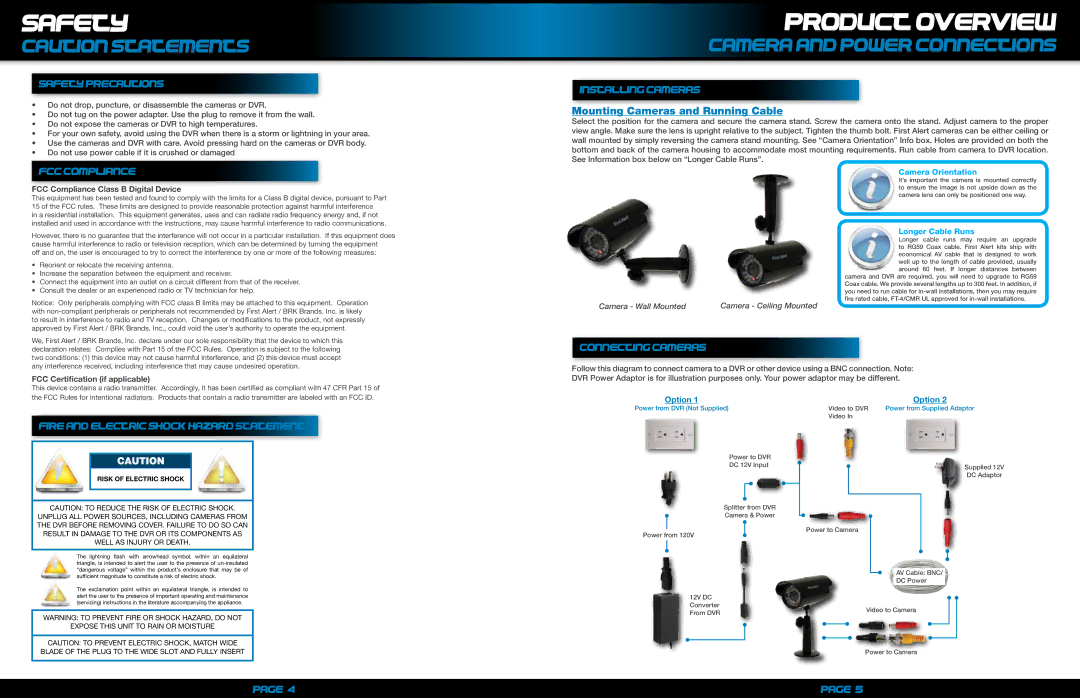
safety
caution statements
safety precautions
•Do not drop, puncture, or disassemble the cameras or DVR.
•Do not tug on the power adapter. Use the plug to remove it from the wall.
•Do not expose the cameras or DVR to high temperatures.
•For your own safety, avoid using the DVR when there is a storm or lightning in your area.
•Use the cameras and DVR with care. Avoid pressing hard on the cameras or DVR body.
•Do not use power cable if it is crushed or damaged
fcc compliance
FCC Compliance Class B Digital Device
This equipment has been tested and found to comply with the limits for a Class B digital device, pursuant to Part 15 of the FCC rules. These limits are designed to provide reasonable protection against harmful interference
in a residential installation. This equipment generates, uses and can radiate radio frequency energy and, if not installed and used in accordance with the instructions, may cause harmful interference to radio communications.
However, there is no guarantee that the interference will not occur in a particular installation. If this equipment does cause harmful interference to radio or television reception, which can be determined by turning the equipment
off and on, the user is encouraged to try to correct the interference by one or more of the following measures:
•Reorient or relocate the receiving antenna.
•Increase the separation between the equipment and receiver.
•Connect the equipment into an outlet on a circuit different from that of the receiver.
•Consult the dealer or an experienced radio or TV technician for help.
Notice: Only peripherals complying with FCC class B limits may be attached to this equipment. Operation with
We, First Alert / BRK Brands, Inc. declare under our sole responsibility that the device to which this declaration relates: Complies with Part 15 of the FCC Rules. Operation is subject to the following two conditions: (1) this device may not cause harmful interference, and (2) this device must accept any interference received, including interference that may cause undesired operation.
FCC Certification (if applicable)
This device contains a radio transmitter. Accordingly, it has been certified as compliant with 47 CFR Part 15 of
product overview
cAMERA AND pOWER cONNECTIONS
Installing cameras
Mounting Cameras and Running Cable
Select the position for the camera and secure the camera stand. Screw the camera onto the stand. Adjust camera to the proper view angle. Make sure the lens is upright relative to the subject. Tighten the thumb bolt. First Alert cameras can be either ceiling or wall mounted by simply reversing the camera stand mounting. See “Camera Orientation” Info box. Holes are provided on both the bottom and back of the camera housing to accommodate most mounting requirements. Run cable from camera to DVR location. See Information box below on “Longer Cable Runs”.
Camera Orientation
It’s important the camera is mounted correctly to ensure the image is not upside down as the camera lens can only be positioned one way.
Longer Cable Runs
Longer cable runs may require an upgrade to RG59 Coax cable. First Alert kits ship with economical AV cable that is designed to work well up to the length of cable provided, usually around 60 feet. If longer distances between
camera and DVR are required, you will need to upgrade to RG59 Coax cable. We provide several lengths up to 300 feet. In addition, if you need to run cable for
Camera - Wall Mounted | Camera - Ceiling Mounted |
connecting cameras
Follow this diagram to connect camera to a DVR or other device using a BNC connection. Note:
DVR Power Adaptor is for illustration purposes only. Your power adaptor may be different.
the FCC Rules for intentional radiators. Products that contain a radio transmitter are labeled with an FCC ID.
fire and electric shock hazard statement
CAUTION
RISK OF ELECTRIC SHOCK
CAUTION: TO REDUCE THE RISK OF ELECTRIC SHOCK.
UNPLUG ALL POWER SOURCES, INCLUDING CAMERAS FROM
THE DVR BEFORE REMOVING COVER. FAILURE TO DO SO CAN
RESULT IN DAMAGE TO THE DVR OR ITS COMPONENTS AS
WELL AS INJURY OR DEATH.
The lightning flash with arrowhead symbol, within an equilateral triangle, is intended to alert the user to the presence of
The exclamation point within an equilateral triangle, is intended to alert the user to the presence of important operating and maintenance (servicing) instructions in the literature accompanying the appliance.
WARNING: TO PREVENT FIRE OR SHOCK HAZARD, DO NOT
EXPOSE THIS UNIT TO RAIN OR MOISTURE
Option 1
Power from DVR (Not Supplied)
Power to DVR
DC 12V Input
Splitter from DVR
Camera & Power
Power from 120V
12V DC
Converter
From DVR
|
| Option 2 | |
Video to DVR | Power from Supplied Adaptor | ||
Video In |
|
|
|
|
|
| |
|
|
|
|
Supplied 12V
DC Adaptor
Power to Camera
AV Cable: BNC/
DC Power
Video to Camera
CAUTION: TO PREVENT ELECTRIC SHOCK, MATCH WIDE BLADE OF THE PLUG TO THE WIDE SLOT AND FULLY INSERT
Power to Camera
Page 4 | Page 5 |
|
|
